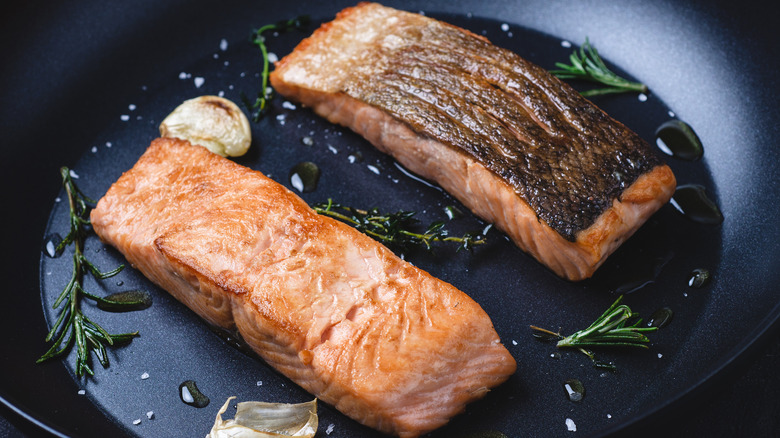Why It Pays To Sear Salmon In A Non-Stick Pan
A fresh piece of fish is a worthy centerpiece of a special-occasion meal, from birthdays to holidays, regardless of the season. It can also be an easy and nutritious weeknight dinner, and even a quick workday salad addition. Regardless of how you intend to enjoy it, seafood of any kind can be a bit of an investment, so you'll want to be sure to get every ounce of flavor out of your purchase.
With that in mind, it's critical to prepare your salmon with the skin on, as this part of the fillet carries a good deal of the fish's deliciousness. When pan-frying your salmon, however, it's always a danger that you'll lose that precious skin, which is naturally a bit sticky. Fear not: Choosing a good non-stick pan will help preserve your salmon's umami-rich flavor and make the fish easier to flip when the time comes. On top of all that, crispy-skinned salmon makes for a beautiful presentation on the plate, to boot.
Why you should eat the skin on your salmon fillet
While some diners are hesitant to eat salmon skin, there are some very good reasons to enjoy this part of the fish rather than toss it in the trash. For one thing, according to Medical News Today, a good deal of nutrients are food in salmon skin, including protein-rich omega 3 fatty acids that promote everything from heart to eye health and may also be beneficial to skincare, blood pressure management, and more.
Additionally, the skin simply adds to the enjoyability of your salmon dish. When prepared with care, salmon skin delivers pleasant textural contrast in the form of a crispy layer that some believe tastes reminiscent of bacon. (You can even save leftover salmon skin to eat as a crunchy topping or snack.) This rich taste is due to salmon's high fat content, much of which is concentrated in the skin of the fish.
How to make and serve crispy-skinned salmon
Beyond flavor and nutrition, the skin is functional to the salmon cooking process, as it keeps your fillet from falling apart in the pan. To achieve crispy-skinned salmon, start by patting down the skin with a paper towel. If you want a little extra crunch, you can score the skin as well. After setting your oiled non-stick pan over high heat, cook the fish skin side-down for a few minutes, after which it will begin to curl up and release from the surface. From there, you'll just need to flip the fish and wait about 2 more minutes to finish cooking the flesh.
As for when to enjoy this versatile protein, the options are limitless. A Thai-inflected mirin glazed salmon makes use of fish sauce for depth and lemon zest for a little zip, while tomato-olive salsa and poblano peppers add a spicy, summery flair to the fish. For a never-sad workday lunch that will keep you sustained, top a Caesar salad with chunks of crispy salmon, or for a hearty brunch addition, top your salmon with an egg. As long as you don't forget to break out the non-stick pan, you've got the formula for a satisfying fish dish.


